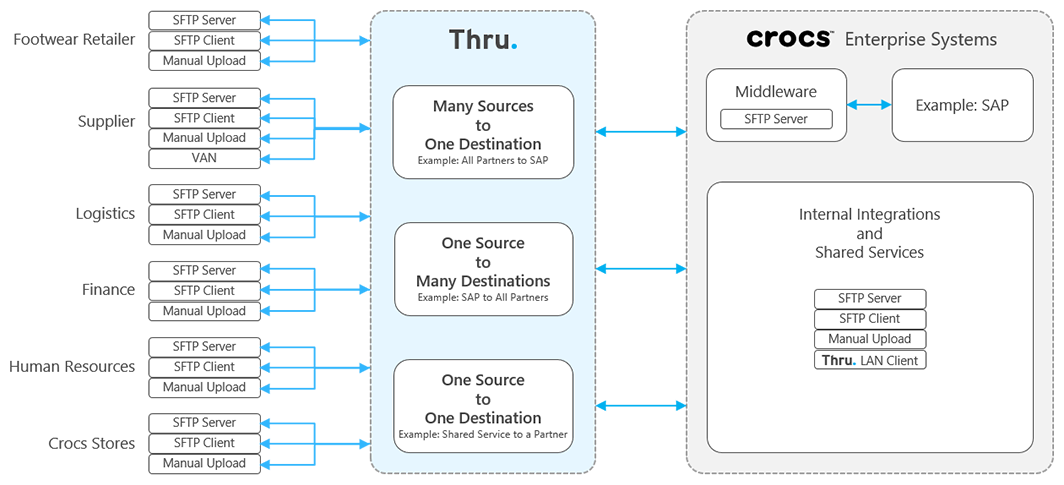63.6% of total IT infrastructure spend will be on the cloud by 2024, according to the International Data Corporation (IDC). The cloud is here and many companies have embarked on this journey.
As public clouds become more popular, you may be considering switching from an on-premises SFTP server or on-premises managed file transfer (MFT) solution to cloud MFT. Let’s learn more about cloud MFT, its inherit features and resulting benefits to make this decision.
What Is Cloud MFT?
Significant benefits of cloud MFT include

Features and Benefits of Cloud File Transfer Technology
1. Cloud Security
One myth about cloud MFT is that its security is less sophisticated than on-premises. This isn’t true. Many cloud MFT vendors provide the same or a much higher level of security than on-premises MFT vendors.
Thru is cloud-native, meaning it was built in the cloud and for the cloud—it was not a “lifted and shifted” on-premises application. Thru’s MFT service has a defense-in-depth architecture, which includes end-to-end encryption (E2EE), antivirus scanning, strict authentication and network monitoring.
2. Easier to Manage
Your IT team needs to set up, maintain and manage scaling for any on-premises MFT solution. In contrast, cloud MFT is easy to manage. Cloud MFT typically has dashboards to see files delivered, their sizes, the retention policy placed on them, etc.
By having visibility into file delivery and activity, your IT team can focus more on profitable and challenging projects.
3. No Coding
You might use on-premises servers or a legacy middleware solution for file transfers. But now, the solution’s age is showing. Your IT team spends hours on coding new point-to-point connections. That takes time away from digital transformation initiatives.
By switching to a cloud MFT solution with a no-code interface, everyone can quickly create workflows and onboard partners.
4. Less Maintenance Time and Costs
With on-premises MFT, you need to purchase and maintain all hardware and software. It requires a high capital cost and a lot of time to “keep the lights on.” Software patches, server replacement, network security, cooling and cabling seem like small investments, but they add up quickly. They also impact your IT team’s ability to take on new projects.
Cloud MFT vendors take on these responsibilities, which lets your IT team focus on revenue, not infrastructure. Pricing is based on usage so you only pay for what you need.
5. No Scaling Costs
On-premises MFT has a lot of guesswork involved in determining how much resource capacity to build out because user demand is unpredictable at first. It’s also expensive to build data centers around the world and provide users with a low-latency, highly responsive experience. Because IT can’t see usage information, they scramble to reduce or ramp up quickly as demand fluctuates.
The beauty of cloud MFT is that resources can be automatically increased or decreased for far less investment. Unexpected swings in user traffic are much easier to handle.
For example, with Thru, users can cost-effectively deploy file transfer workflows to multiple geographies. The software supports millions of transfers without IT involvement, improving their efficiency.
Case Study: Crocs Speeds Up File Transfer Integrations in the Cloud
Crocs, an innovative footwear leader, is dramatically improving its business model with cloud technology. The company has been replacing outdated, on-premises systems that slow down business processes with cloud applications and infrastructure that speed up software development and solution delivery.
After deploying our MFT service in the cloud, Crocs automates file transfer processes and delivers new file transfer flows up to 8x faster. Read the Crocs’ customer success story »
[Note: This post was updated from a post originally authored April 20, 2020.]

